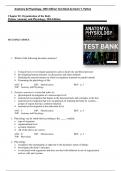Anatomy & Physiology, 10th Edition Test Bank by Kevin T. Patton
Chapter 01: Organization of the Body
Patton: Anatomy and Physiology, 10th Edition
MULTIPLE CHOICE
1. Which of the following describes anatomy?
a. Using devices to investigate parameters such as heart rate and blood pressure
b. Investigating human structure via dissections and other methods
c. Studying the unusual manner in which an organism responds to painful stimuli
d. Examining the physiology of life
ANS: B DIF: Memorization REF: p. 3
TOP: Anatomy and Physiology
2. Systemic anatomy is a term that refers to:
a. physiological investigation at a microscopic level.
b. anatomical investigation that begins in the head and neck and concludes at the feet.
c. anatomical investigation that uses an approach of studying the body by systems—
groups of organs having a common function.
d. anatomical investigation at the molecular level.
ANS: C DIF: Memorization REF: p. 4
TOP: Anatomy and Physiology
3. Physiology can be subdivided according to the _____ studied.
a. type of organism
b. organizational level
c. systemic function
d. All of the above are correct.
ANS: D DIF: Memorization REF: p. 4
TOP: Physiology
4. Physiology:
a. recognizes the unchanging (as opposed to the dynamic) nature of things.
b. investigates the body’s structure.
c. is concerned with organisms and does not deal with different levels of organization
such as cells and systems.
, Anatomy & Physiology, 10th Edition Test Bank by Kevin T. Patton
d. is the science that examines the function of living organisms and their parts.
ANS: D DIF: Memorization REF: p. 4
TOP: Physiology
5. One of the basic principles of the standardized terminology is the avoidance of _____, or
terms that are based on a person’s name.
a. homonyms
b. antonyms
c. eponyms
d. synonyms
ANS: C DIF: Memorization REF: p. 5
TOP: Language of Science and Medicine
6. Metabolism refers to:
a. the chemical basis of life.
b. the sum of all the physical and chemical reactions occurring in the body.
c. an organization of similar cells specialized to perform a certain function.
d. a subdivision of physiology.
ANS: B DIF: Application REF: p. 5 TOP: Characteristics of Life
7. From smallest to largest, the levels of organization of the body are:
a. organism, chemical, tissue, cellular, organ, system, organelle.
b. chemical, microscopic, cellular, tissue, organ, system, organism.
c. organism, system, organ, tissue, cellular, organelle, chemical.
d. chemical, organelle, cellular, tissue, organ, system, organism.
ANS: D DIF: Memorization REF: p. 6
TOP: Levels of Organization
8. The smallest living units of structure and function in the body are:
a. molecules.
b. cells.
c. organelles.
d. atoms.
ANS: B DIF: Memorization REF: p. 7
TOP: Levels of Organization
9. An organization of many similar cells that are specialized to perform a certain function is
called a(n):
a. tissue.
b. organism.
c. system.
d. organ.
ANS: A DIF: Memorization REF: p. 7
TOP: Tissue Level
10. An organ is one organizational level lower than a(n):
a. system.
b. cell.
, Anatomy & Physiology, 10th Edition Test Bank by Kevin T. Patton
c. organelle.
d. tissue.
ANS: A DIF: Memorization REF: p. 7
TOP: Organ Level
11. The reproductive system includes all of the following except the:
a. testes.
b. ovaries.
c. ureter.
d. penis.
ANS: C DIF: Memorization REF: p. 8
TOP: Body Systems
12. The lungs are located in the:
a. thoracic cavity.
b. mediastinum.
c. abdominal cavity.
d. cranial cavity.
ANS: A DIF: Memorization REF: p. 12
TOP: Body Cavities
13. The mediastinum contains all of the following except the:
a. trachea.
b. venae cavae.
c. right lung.
d. esophagus.
ANS: C DIF: Memorization REF: p. 12
TOP: Body Cavities
14. The gallbladder lies in the:
a. abdominal cavity.
b. pelvic cavity.
c. dorsal cavity.
d. mediastinum.
ANS: A DIF: Memorization REF: p. 13
TOP: Body Cavities
15. The number of abdominal regions is:
a. three.
b. five.
c. seven.
d. nine.
ANS: D DIF: Memorization REF: p. 14
TOP: Abdominopelvic Regions
16. The abdominal region in which the urinary bladder is found is the:
a. hypogastric.
b. epigastric.
, Anatomy & Physiology, 10th Edition Test Bank by Kevin T. Patton
c. right lumbar.
d. left iliac.
ANS: A DIF: Memorization REF: p. 15
TOP: Abdominopelvic Regions
17. A surgeon removing a gallbladder should know to find it in the _____ region.
a. right lumbar
b. right hypochondriac
c. hypogastric
d. umbilical
ANS: B DIF: Memorization REF: p. 14
TOP: Abdominopelvic Regions
18. The abdominal region in which the appendix is found is the:
a. hypogastric.
b. right iliac.
c. right lumbar.
d. right hypochondriac.
ANS: A DIF: Memorization REF: p. 15
TOP: Abdominopelvic Regions
19. Popliteal refers to the:
a. calf.
b. ankle.
c. cheek.
d. area behind the knee.
ANS: D DIF: Memorization REF: p. 16
TOP: Latin-based Descriptive Terms for Body Regions
20. A plane through the body that divides the body into right and left sides is called:
a. sagittal.
b. frontal.
c. coronal.
d. transverse.
ANS: A DIF: Memorization REF: p. 16
TOP: Body Planes and Sections
21. The abdominal quadrants are located with what structure as their midpoint?
a. Umbilicus
b. Pubic bone
c. Xiphoid process
d. Iliac crest
ANS: A DIF: Memorization REF: p. 13
TOP: Abdominopelvic Quadrants
22. Humans have similar right and left sides of the body, at least superficially. This is an example
of:
a. anatomical position.




